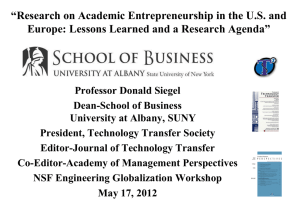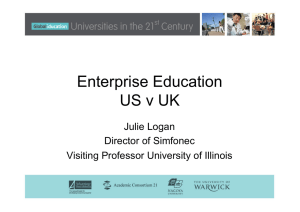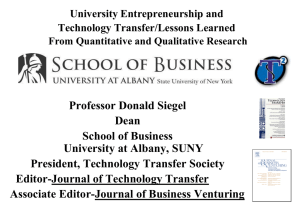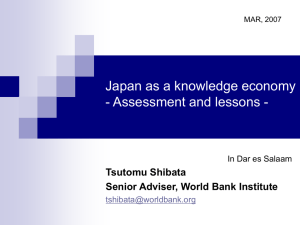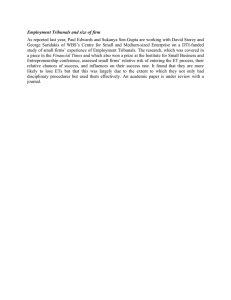“Research on Academic Entrepreneurship in the U.S. and
advertisement
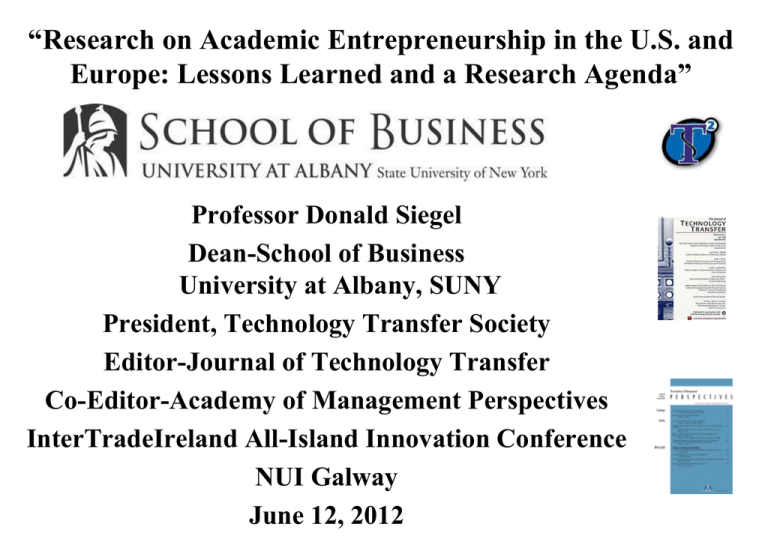
“Research on Academic Entrepreneurship in the U.S. and
Europe: Lessons Learned and a Research Agenda”
Professor Donald Siegel
Dean-School of Business
University at Albany, SUNY
President, Technology Transfer Society
Editor-Journal of Technology Transfer
Co-Editor-Academy of Management Perspectives
InterTradeIreland All-Island Innovation Conference
NUI Galway
June 12, 2012
Outline
Shameless Self-Promotion: Plugs For Technology
Transfer Society/Journal of Technology Transfer/Academy
of Management Perspectives
Background Information on University Technology
Transfer/Academic Entrepreneurship
Summary of Key Research Quantitative and
Qualitative Results From the Burgeoning
Literature on University Technology Commercialization
/Academic Entrepreneurship
Agenda for Additional Research
Economics of Innovation and Entrepreneurship
Joseph Schumpeter (1939)Stresses the Importance of Technological Competition,
Not Price Competition-The Role of the Entrepreneur
Technological Change is a Force of “Creative
Destruction”
Zvi Griliches/Edwin Mansfield/Richard Nelson-Diffusion
of Innovations/R&D is a Key Source of Economic Growth
(Especially Basic Research)/Technology Transfer/Role of
Universities
Universities, “GPTs”, and The Creation of New Industries
Technology
(Primary)
Industry
Period Developed
University
Created
Electronic
University of
1940s Calculator
Pennsylvania
Computers
Fiber
1960s
Optics
MIT
Telecommunications
1970s
rDNA
1980s Supercomputing
Stanford,
California
Illinois
Biotechnology
Internet
Sequencing of DNA/
Human Genome
Cal Tech,
1990s
Project
Johns Hopkins Pharmacogenomics
2000s Nanotechnology
UAlbany
?????
Background Information on
University Technology Commercialization
U.S.-1960’s, 1970’s Decline in Competitiveness
(“Japanese Challenge,” Productivity Slowdown)
Dramatic Changes in U.S. National Innovation Policy
Expansion of Programs to Support Public-Private
Partnerships (e.g., Advanced Technology Program-ATP,
NSF-ERC, IUCRC)
Relaxation of Antitrust Enforcement to Promote
Collaborative Research (e.g., NCRA)
Policies Promoting More Rapid Diffusion of FederallyFunded Technologies From Universities and Federal Labs
to Firms (e.g., Bayh-Dole, Stevenson-Wydler, SBIR )
Legacy of the Bayh-Dole Act
Bayh-Dole Act of 1980: Universities Own the Rights to
Technologies That Arise from Federal Research Grants
Purpose: Accelerate the Rate of Technological
Diffusion, Promote Economic Development
Almost All Universities Have Established a Technology
Transfer or Licensing Office
Rapid Growth in Commercialization of University
Technologies:
U.S. Universities
1980
2010
University Patents
300
4469
Licensing Agreements
276
4284
Startups
35
651
Interdisciplinary Research on Institutions and Agents
Involved in Academic Entrepreneurship
Agents and Institutions
University Scientists
Industry Scientists
Entrepreneurs
Industry-University Cooperative Research Centers
University Technology Transfer Offices
Science Parks
Incubators/Accelerators
Firms That Interact With Universities
Venture Capital Firms
Selected Research Questions
How Does the Process of University Technology
Commercialization/Academic Entrepreneurship Work?
Which Universities “Perform” Best?
What is the Role of the TTO?
How Should We Measure Performance?
Which Factors “Explain” Variation in Relative
Performance? (e.g., Incentives, Organizational, and
Environmental Factors)
Do Incubators/Accelerators and Science Parks Add
Value?
Interdisciplinary Research on Institutions and Agents
Involved in Academic Entrepreneurship
Indicators of Output/Performance
Invention Disclosures
Patents
Number of Licensing Agreements
Licensing Revenue
Research Productivity of Industry Scientists/Firms
Research Productivity of University Scientists
“Productivity” of Universities in Technology Transfer
Start-Up Formation
Survival
Employment Growth
Changes in Stock Prices
NBER/Alfred P. Sloan Foundation Project on
Industrial Technology and Productivity
Theme: Economists Need to Supplement Statistical
Analysis of Productivity and Technology
With “Pin-Factory” Visits:
Inside the “Black Box”:
Organizational Structure-Milgrom & Roberts (1992)
HRM-Lazear (1995)
Strategy-Jensen (1998)
Technology Transfer Offices-Siegel et al. (1999)
Goals of My Original NBER/Sloan Study
Specify a UTT “Production Function”
“Explain” Relative Productivity in UTT
(Assess the Relative Importance of Organizational
Factors in Explaining Variation in UTT Performance)
Tactics of the NBER/Sloan Study
Quantitative Methods-Constructed Estimates of the
Relative Productivity of 113 U.S. Universities with
Regard to Licensing
Qualitative Methods-Inductive Analysis to Explore
Organizational Issues, Based on Structured Interviews of
Academic and Industry Scientists, University
Administrators, and Firms/Entrepreneurs
FIGURE 1
How A Technology is Transferred from a
University to a Firm or Entrepreneur
(According to Theory)
Scientific
Discovery
Invention
Disclosure
Evaluation of
Invention for
Patenting
University
Scientist
University
Scientist
and TTO
University
Scientist
and TTO
Patent
University
Scientist
and TTO
Marketing of
Technology to
Firms
Negotiation
of
License
License
to Firm
(an existing firm
or startup)
University
Scientist, TTO,
and
Firm/
Entrepreneur
University
Scientist,
TTO, and
Firm/
Entrepreneur
University
Scientist,
TTO, and
Firm/
Entrepreneur
Key Stylized Facts From My Qualitative Research
(Relevant to the Measurement and Analysis of the
Effectiveness of Technology Transfer)(Siegel et al., 2003a, 2003b, 2004)
Patents Are Not that Important for Certain
Technologies/Industries
Many Scientists do not Disclose Inventions
Faculty Involvement/Engagement is Critical
Universities Often Hire Outside Lawyers to Negotiate
with Firms
Multiple “Outputs” (e.g., licensing, startups, sponsored
research )
UTT Production Function
LICENSE & STARTUP=f (INVDISC, STAFF, LEGAL )
where LICENSE = licensing agreements or revenue
STARTUP = start-up activity (counts)
INVDISC = invention disclosure
STAFF = TTO staff
LEGAL = (external) legal expenditures
We also need to account for environmental,
institutional, and organizational factors that are not
typically included in a production function.
Choices: Parametric or Nonparametric Estimation?
Single vs. Multiple Outputs?
UTT Production Function
LICENSE & STARTUP=f (RESEARCH, STAFF, LEGAL )
where LICENSE = licensing agreements or revenue
STARTUP = start-up activity (counts)
RESEARCH = research expenditure
STAFF = TTO staff
LEGAL = (external) legal expenditures
We also need to account for environmental,
institutional, and organizational factors that are not
typically included in a production function.
Choices: Parametric or Nonparametric estimation?
Single vs. Multiple Outputs?
Frontier Production Function
(Single Technology Transfer Output and Input)
Technology
Transfer
Output
(e.g.
Licensing)
Best Practice
Frontier
(non-parametric)
Regression
Line
(parametric)
Technology Transfer
Input (e.g., Research)
Non-Parametric:
Data Envelopment Analysis (DEA)
s
m
Max Ek = S urkYrk / S vikXik
r =1
i =1
subject to
s
m
S urkYrj / S vikXij 1; j=1,..., n
r=1
i=1
All urk > 0; vik > 0
where i=inputs (m inputs)
r=outputs (s outputs)
n=# of DMUs (Decision Making Units)
Data Envelopment Analysis (DEA)
-Two-Stage Analysis
1st Stage: DEA generates efficiency “score”
(0 < E<1)
2nd Stage: E = b0 + b1Z1 + b2Z2 ... +bkZk
where Z1 through Zk are environmental, institutional,
and organizational factors)
Stochastic Frontier Estimation (SFE)-Single Output
yi = xi + I
where
i is an error term with two components:
i = V i - Ui
where
Ui represents technical inefficiency
Ui i.i.d. N+(0,2u ), ui 0
Vi i.i.d. N(0,2v )
Stochastic Frontier Estimation (continued)
SFE with environmental variables:
Assume that Ui are independently distributed as
truncations at zero of the N( mi,2u ) distribution
with:
mi = zi
where z is a vector of environmental/
institutional/ organizational factors
Multiple Outputs: Distance Function approach
(can be estimated with Parametric
or Nonparametric Methods)
Multiple Output Distance Function
Do(x,y) = min{: (y/ P(x)}
STARTUP
=0A/0B
B
STARTUPA
A
P( x)
0
LICENSEA
LICENSE
Stochastic Frontier Production Function Model
Stochastic Production Function (Paper-CD, Also TL)
ln(LICENSEi) and ln(STARTUP)
=0+1 ln(RESEARCHi)+2 ln(STAFFi)
+3 ln(LEGALi) + γ11 ln(RESEARCHi)2
+ γ22 ln(STAFFi)2 + γ33 Lln(LEGALi)2
+ γ12 ln(RESEARCHi)ln(STAFFi)
+ γ23 ln(STAFFi)ln(LEGALi)
+ γ31 ln(LEGALi)ln(RESEARCHi) + Vi - Ui
Determinants of Inefficiency
Ui = 0 + M MEDSCHi + INC INCUBij+ SCI SCIij + AAGE i
+ INDPERCINDi + i
Selected Empirical Studies of
University Technology Licensing
Author(s)
Methodology
Siegel et al.
(2003)
Productivity of
Licensing-SFA
Thursby and
Kemp (2002)
Results
Organizational and
Environmental Factors Have
Considerable Explanatory Power
Productivity of Private Universities More Efficient
Licensing-DEA
Productivity of
Licensing-DEA
Growth in Licensing/Patenting
Due to an Increase in the
Thursby and
Willingness of Professors to Patent
Thursby (2002)
and License and Firm Outsourcing
of R&D
Higher Royalty Shares For Faculty
Siegel et al.
Productivity of Associated With Greater Licensing
(2005)
Licensing-SFA Income; Land Grant Universities
Are More Efficient
Author(s)
Siegel et al.,
(2003)
Siegel et al.
(2006)
Selected Empirical Studies of
University Technology Licensing
Methodology
Results
Three Key Impediments:
Informational and Cultural
Barriers Between Universities and
Firms (Especially for Small Firms)
Insufficient Rewards for Faculty
Involvement in UITT
Quantitative TTO Staffing and Compensation
Practices (e.g., High Rate of
Analysis of
Turnover, Insufficient Business/
Qualitative
Marketing Experience)
Data
Productivity
of Licensing
and Startups
–Distance
Function
U.S, Universities More Productive
Than U.K. Universities;
Universities With Medical Schools
and Incubators More Efficient
Selected Studies of University Science Parks
Author(s)
Siegel,
Westhead, and
Wright (2003)
Westhead and
Storey (1995)
Link and Scott
(2003)
Unit of Analysis
Results
Firms Located Firms Located on University Science
on Science
Parks Have Higher Research
Parks (U.K.) Productivity Than Comparable
Firms
Firms Located Science Park Firms With a Link to
on Science
the University Have a Higher
Parks (U.K.) Survival Rate Than Science Park
Firms Without Such a Link
Science Parks
(U.S.)-Based on
Self-Reported
Qualitative
Data
Proximity to a University and
Availability of Venture Capital
Enhance Growth; Science Parks
Enable Universities to Generate
More Publications and Patents,
More Easily Place Graduates, and
Hire Preeminent Scholars
Selected Empirical Studies of University-Based Start-ups and
Entrepreneurial Activity at Universities
Author(s)
Louis,
Blumenthal,
Gluck, and Stoto
(1989)
DiGregorio and
Shane (2003)
Markman, Phan,
Balkin, and
Gianiodis (2005)
Unit of Analysis
Faculty
Members in the
Life Sciences
Results
Key Determinant of FacultyBased Entrepreneurship: Local
Group Norms; University
Policies and Structures Have
Little Effect
UniversityBased Startups
Two Key Determinants of Startup Formation: Faculty Quality
and Equity-Friendly University
Policies
TTOs and
University
Startups
The Most Attractive Licensing
Strategies For Entrepreneurship
Are Least Likely to Favored by
the University (Due to Risk
Aversion and Short-Run Revenue
Maximization)
Selected Empirical Studies of University-Based Start-ups (cont.)
Author(s)
Unit of Analysis
Relationships
Involving “Star”
Zucker, Darby,
Scientists and
and Brewer
U.S. Biotech
(1998)
Firms
Markman, Phan,
TTOs and
Balkin, and
University-Based
Gianiodis (2004a)
Startups
Siegel et al. (2003) TTOs and Firms
Results
Location of Star Scientists
Predicts Firm Entry in
Biotechnology
Equity Licensing and Startup
Formation Are Positively
Correlated With TTO Wages;
TTOs Serve the Needs of Large
Firms More Effectively Than
Those of Small, Entrepreneurial
Companies
Key Quantitative Results
Production Function Models Provide a Good Fit
Results Are Fairly Robust to Single or Multiple
Outputs
Staff in the Technology Transfer Office Add Significant
Value to the Commercialization Process
No Strong Consensus on Returns to Scale
Bayh-Dole Type Legislation Appears to Have Been
“Effective”
Private Universities and Those With Medical Schools
Appear to Be Somewhat More Productive
Key Quantitative Results (cont.)
Property-based Institutions (Incubators and Science
Parks) Appear to Enhance Technology
Commercialization
Incentives Matter (e.g., Royalty Distribution Formula),
But So Do Organizational Practices and Other
Institutional Policies
Universities Are Becoming More “Strategic” in
Technology Transfer (More On That Later) –More
Heterogeneity and Application of Management Theories
to Practice
Key Quantitative Results (cont.)
Universities Increasingly Focusing on the Entrepreneurial
Dimension (Evidence Mixed on Success of University Based
Startups)
Academic Entrepreneurs Are Not Less Productive in Their
Academic Research After Commercialization
Foreign-Born Scientists Are More Likely to Become
Academic Entrepreneurs
Social Networks of Star Scientists Key for New Firm
Creation
Key Stylized Facts From Qualitative Research
Major Impediments to University Technology Transfer:
Informational and Cultural Barriers Between
Universities and Firms (Especially for Small Firms)
Insufficient Rewards for Faculty Involvement in
Technology Transfer at Some Institutions, Especially
w.r.t. Entrepreneurial Activity
Technology Transfer Office Staffing and Compensation
Practices (High Rate of Turnover, Insufficient Business/
Marketing Experience, Possible Need for Incentive
Compensation)
Education/Training is Needed for Faculty Members, PostDocs, and Graduate Students in the Specifics of the
Entrepreneurial Process, the Role of Entrepreneurs, and
How to Interact with the Business/Entrepreneurial
Community
Key Stylized Facts From Qualitative Research (cont.)
A Failure to Address These Barriers Will
Induce More Faculty Members and Firms to
Circumvent the TTO and Engage in
“Informal” UITT
University Technology
Transfer/Commercialization/Entrepreneurship
Should be Considered From a Strategic Perspective
Strategic Implications of University Technology Transfer
/Academic Entrepreneurship-Formulation Issues
Setting Institutional Goals/Priorities
Resources Devoted to University Technology Transfer
Choices Regarding Technological Emphasis
Strategic Choices Regarding Modes of University
Technology Transfer:
Licensing
Startups
Sponsored Research
Other Technology Transfer Mechanisms That are
Focused More Directly on Stimulating Economic
Development (e.g., Incubators and Science Parks)
Strategic Implications of University Technology Transfer
/Academic Entrepreneurship-Implementation Issues
Improving Information Flows
Organizational Design/Structure
HRM Practices-Staffing/Compensation of TTO
Personnel
Reward Systems for Faculty Involvement in University
Technology Transfer (perhaps including P&T- e.g., 6/06-Texas A&M)
Implementation Issues Regarding Modes of University
Technology Transfer
Different Ways of Structuring Licensing Agreements
Academic vs. Surrogate Entrepreneurs
Different Ways to Manage University-Based
Incubators and Science Parks
Unanswered Research Questions
(Mainly in the Domains of Management and Economics)
Which Organizational Practices Enhance Performance?
What is the Role of Department/Organizational Culture?
What is the Role of Organizational Structure?
What is the Role of Leadership (“Entrepreneurial
Leadership”)?
“Nature vs. Nurture” (e.g., Role of Genetics vs.
Environment)
What are the Tradeoffs Associated With Involvement in
Academic Entrepreneurship (e.g., Educational, Basic
Research)?
Unanswered Research Questions
(Mainly in the Domains of Management and Economics)-cont.
Additional Benchmarking Issues (e.g., International
Comparisons)
Evaluation of Entrepreneurial Initiatives and Programs
National Level-(e.g., SBIR)
State Level-(e.g., Ben Franklin Technology Partners)
What is the Relationship Between Technology
Commercialization and Ethics/Corporate Social
Responsibility?
Better Measures of the Private and Social Returns to
University Technology Commercialization/ Entrepreneurship
(e.g., need better data-most data at the institutional level)
Personal Reflections Based on
Studies of Academic Entrepreneurship
We Need More Detailed Exploration of the Nature of the
Connection Between Entrepreneurial Firms and the
University, Including the Role of Property-Based Institutions
(i.e., Incubators/Accelerators & Science/Technology Parks
What is The Relationship Between Academic
Entrepreneurship and Federal/National Labs (The “Last
Frontier” of Technology Transfer)
We Need More Detailed Analysis of Technology Transfer
Strategy Implementation
Personal Reflections Based on
Studies of Academic Entrepreneurship (cont.)
Strong Need to Enhance Incentives for Faculty Members to
Be Engaged in Entrepreneurial Activity (and Perhaps For
Successful Ones to Serve As Mentors)
Important to Increase Participation/Success of Women &
Minorities in Academic Entrepreneurship (as we found in
the NRC Evaluation of SBIR)
Entrepreneurship Research, Education, and CommunityBased Initiatives Are Key Complements
Entrepreneurship As An Academic Field
Entrepreneurship (2007) vs. Strategy (1989)
Returns to Studying This Topic Are High (e.g., NSFIGERT, Kauffman, development)
